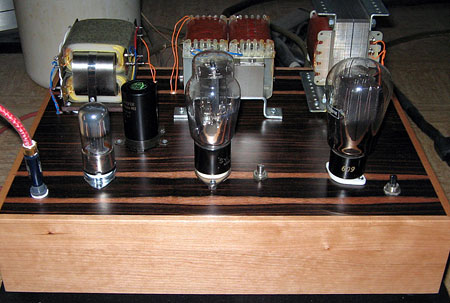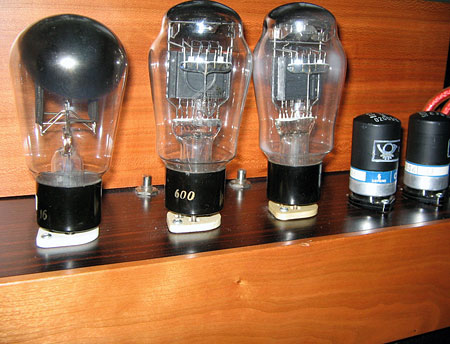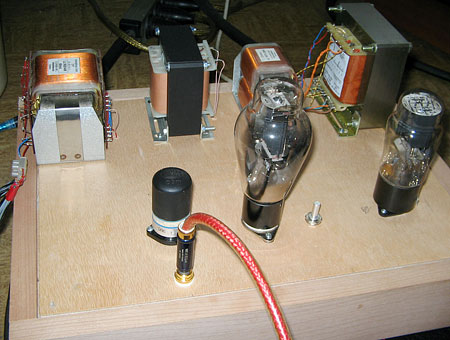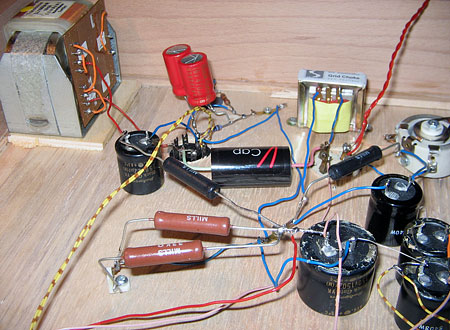|
|
|||||||||
Virtually everyone loves the sound of triodes. But few are as clear about the role components play in making these simple circuits sing as Erwin Wiesbauer, a circuit designer and V-Cap user from Germany. Here's what Erwin Wiesbauer has to say about using V-Caps in his designs: "Both 0.1 CuTF pairs are still running in my 2A3 and KT63 amps, I never soldered them out. Finally I've got some 0.22s and 0.33s to complete my system some weeks ago. They are very heavy - did you include a big piece of lead? :-) I replaced the TFTFs at the outputs of phono and line stage. At the beginning the change to CuTF was not very impressive. But the longer I listened the V-Caps woke up and several weeks later I am very happy about the improvement.
One should not expect sensational and spectacular things - but when they awaken it is clearly audible what the CuTFs do. The extremely balanced sound may not impress much although this point is almost sensational, because there is no other capacitor that provides such a tonal balance. My conclusion is that this extraordinary good tonal balance allows the listener to realize very low level musical details. I listened to some old LPs I listened to some years ago. I was amazed - I could hear unknown before things, f.e. the way of singing of the musician. The voice benefits A LOT with the CuTFs. Congratulations once more for this capacitor! The price is high but my philosophy is do more with less, that means simple circuits, few but high quality parts. Therefore I don't need much capacitors and is still affordable. "
Follow up: The level of audio quality has significantly raised. Such caps are not a weak point in the chain anymore. I often design tube amps, and transformer coupling was the only way to bypass the coupling cap problem. But Interstage transformers have other problems. In a driver stage I recommend LC coupling (plate choke + V-Cap), in a line stage RC coupling is excellent (with V-Caps). The TFTF and CuTF capacitors are a big step forward. Designing amps is easier now. I just finished my 50 amp (image on left) including LCL coupling. That means plate choke - cap - grid choke. You will find the anonyme 0.1 CuTF again. This amp sounds great, smooth and open at the same time, you know how difficult is to get such results.
Comment to elusive_4-pic (image on left): Worldwide resources are necessary to realize such a great sounding amp: Amorphous core plate choke and output transformer from Sweden, Black Gate capacitors, Permalloy grid choke and Tantalum resistors from Asia, WBT nextgen connectors and C3m driver tube from Germany, type 50 power triode, V-Cap capacitors and Mills resistors from USA! I am always again amazed how simple triode in SE circuits are. Few, but high quality parts are mandatory! Follow-up: I enjoyed Alex' comments - "a huge step forward" - yes it is! "You are truly listening to music as it is performed and not to a hi-end audio contortion of it.". This is the quintessence of the V-Cap CuTF! They allow a very deep insight to the music. This was never possible before. "The absence of artificiality allows me the freedom to lose myself totally into the music. What a joy!" My experience is exactly the same. Joy - yes! As I stated almost last year, this capacitor makes the listener very happy. I guess, the CuTF lets pass a lot of low level details of the music. An emotional musical encounter. No V-Cap CuTF - no music! I wonder how you made it, finding such a great cap. I can imagine, a lot of work, a lot of comparing. I want to pinpoint the music is not affected by nervousness anymore. Quiet music sounds quiet and relaxed but never boring. I feel peace inside the music. Furthermore, good old rock music sounds great. I listened to "Machine Head" by Deep Purple. Music pure. I mostly find this music a little too primitive but there is a lot of drive! Again, pure fun. Erwin Wiesbauer I asked Mr. Wiesbauer if he could share a bit about his design experience and philosphy, and this was his reply (published with his permission): My circuits are nothing special at the first view. They never tell the experience behind. It's the same as with your V-Caps - your experience cannot be seen but it is audible! Triodes and SE: For 14 years I've evaluated tubes, circuits and parts. I think I've grown with my tube system (or vice versa?). I principally avoid all things which may be usual, but bad for good sound, f. e. Push Pull pentode, Class AB or B, negative feedback loops, cathode followers (with one exception), solid state parts, antenna and computer tubes (417A, 5842, 6DJ8). Power and sound quality is like cat and mouse. The biggest challenge was to calculate a RIAA eq network (one must be able to, otherwise one cannot create new circuits) which is very easy now thanks to the internet. Another challenge was to try a triode Push Pull amp. I choosed KT63s (not KT66s) and phase splitting was made by a simple autoformer (thank you, Electra-Print!) ! A super simple circuit. Like the Quad II and the McIntosh I used cathode feedback (cathode is connected to a winding of the output transformer). Sound was very fine but I preferred the 2A3 and 50 amps. Designs I have built? Countless! And most of them do not exist anymore. I developed a phono and line stage over a longer time. I begin with a circuit and change several tube types until I am pleased with the sound. Amps are easier, because I use the C3m tube to drive the power triodes. At the moment I cannot find a better driver than the C3m. My line stage did see lots of tubes come and go! First DHTs (71A, 10) replaced by paralleled 6SN7 and C3m + line OPT. Later I tried the 27,37,56,76 cathode bias into a DC coupled cathode follower. Cathode follower is against my religion but the sound is superb. I was very pleased about the very smooth and romantic sound of the 56 but sometimes a little too dark. I replaced it with RCA VT-231 (grey glass) and the darkness has gone, fortunately not at the price of a bright sound. My work is nothing different than to find the best tonal balance - I am sure you did the same with the V-Caps, therefore I am sure you understand my "journey". When a phono or line stage is finished, I begin a 2nd project using other or partly other tubes. It is really very difficult to find a second tube combo with the same sonic level as the first phono stage! Mr. Wiesbauer has graciously provided schematics for his designs, which are available for download below (.gif images last updated - 7-30-2012) "Chanchullo" RE604"Mount Rainier" 2A3 amplifier"The Elusive" Type 50
READ MORE REVIEWS of the V-Cap Capacitors
|
|||||||||
|
|
|||||||||

 "Chanchullo" RE604 Amplifier
"Chanchullo" RE604 Amplifier
